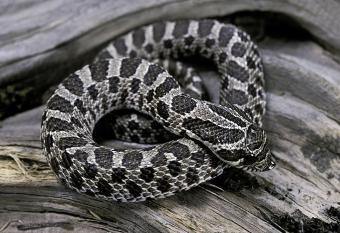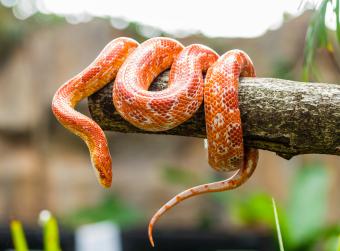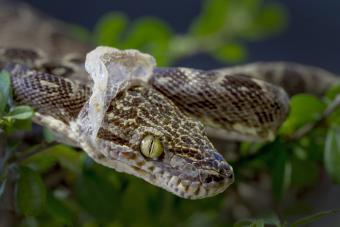
Although the hognose snake isn't the most popular reptile to keep as a pet, it is growing in popularity over time. Their unique features and abnormal behavior attract snake enthusiasts nationwide. They're also relatively easy to care for, making them good pets for beginners. They might prefer their alone time over time with you, though, if you don't get them when they're young.
Types of Hognose Snakes

If you're looking into getting a hognose snake as a pet, it's important to understand there isn't only one species. In fact, there are several species of hognose snake, including the Eastern Hognose snake, Western Hognose, Southern hognose, Speckled Hognose snake, and the Tricolor Hognose snake. The species most commonly kept as pets are the Southern, Western, and Eastern Hognose snakes.
History and Native Habitat
Hognose snakes are found throughout the United States and Mexico:
| Type of Snake | Native Habitat |
| Western Hognose | Southern Canada |
| American Midwest | |
| American South | |
| Northern Mexico | |
| Eastern Hognose | Ontario |
| Florida | |
| Wisconsin | |
| Texas | |
| Kansas | |
| New Hampshire | |
| Southern Hognose | North Carolina |
| Mississippi | |
| Florida |
Are Hognose Snakes Venomous?
Hognose snakes are members of the pit viper family, but they are not venomous. In fact, most hognoses generally play dead to avoid predation. They get their name from the upturned snout of the animal. These snakes are often confused with rattlesnakes because they have similar markings.
Appearance
The Hognose snake is usually about 1 to 2 feet long when fully grown, but can measure up to 3 feet in length. They have several distinctive features that make it easy to identify; their upturned snout, wide head, and large eyes give them an appearance similar to that of a pig or frog.
Hognose coloration varies from grey to brown with dark blotches across its back and sides. The underside may be cream or yellow in color with black blotches covering it. This helps camouflage the snake when resting on sandy ground by allowing it to blend into its habitat more easily.

Hognose snakes have a toxic saliva made from a gland known as the Duvernoy's gland, but it's generally not harmful to humans.
Temperament
The Hognose snake is fairly timid and doesn't particularly enjoy being handled. They aren't known to be aggressive, but they likely won't come out to greet you, either. If they are concerned with your presence, you may also notice some unusual behavior. If you don't expect it, this could be quite alarming.
Hognose snakes are known for their ability to play dead when threatened by predators or during mating rituals. When they feel threatened, they will often roll over onto their back with their mouth open and tongue hanging out, while making hissing noises to scare away predators or competitors.
Hognose snakes enjoy their time alone, so if you want more than one snake in the habitat, make sure there's enough territory for them each to have their own space.
Handling Your Hognose Snake
As long as these snakes are socialized properly from an early age, they take to handling very well. While they may bluff threat displays for you, they are not aggressive and these displays are not dangerous. Just don't pick your snake up in the middle of such a display. Instead, wait for it to calm down before trying to handle it.
Lifespan
The lifespan of the snake is important in considering which species you would like to keep as a pet. Their lifespans are:
- Southern Hognose: 5 to 8 years
- Eastern Hognose: 5 to 9 years
- Western Hognose: Up to 20 years
If you're interested in acquiring the Western Hognose snake, take a moment to consider whether you're ready to care for a snake for up to 20 years. If not, another species may suit you better.
Care Requirements
The western hognose snake is increasingly popular and is one of the easiest snakes to care for. They also make excellent display animals for advanced hobbyists looking for something different from a typical ball python or boa constrictor.
Terrarium
Hognose snakes are not picky about their housing conditions. In fact, they prefer a more natural setup with plenty of hiding spots and an environment that mimics their native habitat. This makes them an ideal pet for beginners because they don't require a huge investment in equipment or supplies.
A Hognose snake terrarium should be large enough to allow your pet plenty of room to move around while still providing spots to hide. A minimum size of 24 inches long by 12 inches wide by 12 inches tall is recommended for a single adult snake, but you may need to increase this if you have multiple snakes in one enclosure or if you plan on breeding your snake in the future.
Temperature and Humidity
All snakes require a temperature gradient in their enclosure. This allows them to regulate their body temperature by simply moving from one side of the cage to the other. Hognose snakes require temperatures between 80 to 85 degrees Fahrenheit during the day, with a slight drop at night down to 75 degrees.
Keep humidity around 40 to 45%. In captivity, you should provide a hide box that is about 3 to 4 inches deep for them at one end of their enclosure so they can get away from direct heat if desired.

Light
The best way to keep your hognose snake healthy is with proper lighting in its terrarium. You'll want to provide full-spectrum lighting for your pet, which means it needs both UVA and UVB rays. These rays help your snake produce vitamin D3, which helps with calcium absorption and muscle contraction.
You can purchase full-spectrum lights from pet stores or online retailers. These bulbs come in many sizes and wattages; choose one that provides a sufficient amount of light for your snake's enclosure but doesn't overheat it when it's turned on for long periods of time.
Substrate
Hognose snakes are well known for burrowing beneath the topsoil. Your chosen substrate should encourage this instinctive behavior. They should have at least 5 inches of substrate to burrow. You can purchase a pre-packaged mixture of topsoil and sand or make your own. If you make your own, approximately 70% of the mixture should be untreated topsoil with the remainder consisting of play sand. The mixture should be dry before placing your snake in the terrarium.
Aspen shavings are also extremely popular, especially for western hognose snakes. Change your snake's bedding at least every 7 to 14 days. Loose bedding options, such as appropriate wood shavings, allow your hognose to burrow down and hide in the substrate.
Diet and Water for Hognoses
Hognose snakes most commonly consume frogs and toads in their native habitat. In captivity, they can consume frozen mice. Live mice can cause serious injury and should be avoided, if possible. If your hognose refuses to feed, they likely need you to stimulate their prey drive. Use a long set of forceps or tongs, and giggle their thawed mouse or rat dinner to simulate movement.

Provide fresh, clean water in a shallow, heavy bowl designed for use with snakes. Make sure you change this water regularly, and top up their bowl as necessary.
Difficulty Feeding
Hognose snakes can be difficult to feed and may take several days to eat their first meal. They do best on mice or small rats, but a good rule of thumb is that if the mouse is larger than the snake's head, it will not fit into its mouth. The snake will use its tongue like a lure to attract prey, then strike when the animal gets close enough.
One of the biggest challenges with keeping a hognose snake as an exotic pet is getting them to eat consistently enough so that their nutrition needs are met.
Health Concerns
The following are health concerns associated with hognose snakes:
- Respiratory infection: There are many potential causes for this problem, including stress, poor diet and improper temperatures.
- Stomatitis: Stomatitis is an inflammation of the mouth that often results in ulcers on the tongue, gums and inner surface of the mouth. It can also cause swelling and discomfort for the snake. The exact cause of stomatitis is not always known but it may be due to a bacterial infection or a fungal infection.
- Impaction: Impaction is a common occurrence in hognose snakes. Most commonly, it occurs when a snake eats prey that is too large for it to digest. Impaction can occur if the snake's digestive tract becomes clogged with feces or if the snake is constipated.
You may notice your hognose snake slow down from November through February as it attempts to brumate - similar to hibernation. Remain observant of your snake to ensure they are healthy during this time period, but try not to disturb them or handle them.
Finding a Hognose Snake
These snakes are not commonly found in pet stores because they are difficult to breed in captivity. However, you can frequently find them at reptile shows or for sale by reptile enthusiasts and breeders. You can expect to pay between $100 and $500 for a Hognose snake depending on their age and species. You may be able to find better prices if you find a reptile enthusiast near you or you attend a reptile expo.
Is the Hognose Snake for You?
Before purchasing a Hognose snake, determine which species best suits your lifestyle. Some live longer than others. Ask yourself if you're searching for a lower time commitment or if you're prepared to care for a snake up to 20 years. If you are looking for a snake that is different from the rest and doesn't require a significant amount of attention, then this may be the right choice for you.







